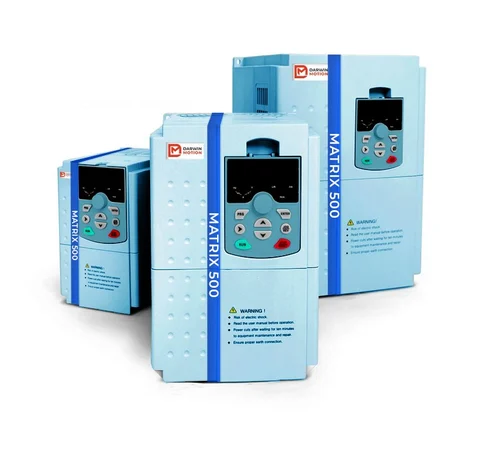Posted on 1st Mar 2024

In the realm of modern industrial machinery and automation, efficiency and precision are paramount. One technology that plays a crucial role in achieving these goals is the high-frequency drive (HFD). Also known as variable frequency drives (VFD) or variable speed drives (VSD), these sophisticated electronic devices control the speed and torque of electric motors by varying the frequency and voltage of the power supplied to them. Understanding the working principle of Darwin Motion high-frequency drives (DR Matrix 500) is essential for comprehending their applications and benefits across various industries.
High-frequency drives are extensively used in applications where precise control of motor speed is required. They find application in industries ranging from manufacturing and HVAC (heating, ventilation, and air conditioning) to energy and transportation.
At the core of a high frequency drive lies a sophisticated power electronics system. This system converts the incoming AC power into DC and then back to AC at the desired frequency and voltage. By adjusting the frequency and voltage of the output AC waveform, the speed and torque of the connected motor can be precisely controlled.
Working Principle:
The working principle of a high-frequency ac drive involves several key components and processes:
Rectification: The incoming AC power is first rectified to DC power using diodes. This process ensures that the power input to the drive is converted from alternating current (AC) to direct current (DC).
DC Bus: The rectified DC power is then stored in a DC bus capacitor bank. This capacitor bank acts as a buffer, smoothing out any fluctuations in the incoming power and providing a stable DC voltage for the subsequent stages of the drive.
Inverter: The DC power from the bus is then fed into an inverter, which converts it back to AC power. The inverter uses insulated gate bipolar transistors (IGBTs) or metal-oxide-semiconductor field-effect transistors (MOSFETs) to rapidly switch the DC voltage on and off, effectively creating a series of pulses.
Pulse Width Modulation (PWM): The width of these pulses is controlled using a technique called pulse width modulation (PWM). By adjusting the width of the pulses, the effective voltage and frequency of the output AC waveform can be varied, thus controlling the speed and torque of the motor.
Control System: A control system, often comprising microprocessors and specialized algorithms, regulates the operation of the drive. It monitors parameters such as motor speed, current, and voltage, and adjusts the output frequency and voltage accordingly to maintain the desired operating conditions.
Energy Efficiency: By controlling the speed of motors based on the actual requirements of the system, high-frequency drives can significantly reduce energy consumption compared to traditional fixed-speed setups.
Improved Process Control: The precise speed and torque control offered by high-frequency drives enable finer control over industrial processes, leading to improved quality and productivity.
Soft Start/Stop: High-frequency drives allow for soft starting and stopping of motors, reducing mechanical stress and wear on equipment, as well as minimizing electrical transients and disturbances in the power supply.
Space Savings: High-frequency drives are compact and modular, requiring less space than traditional motor control systems, thus offering greater flexibility in installation and layout.
Versatility: High-frequency drives can be used with a wide range of motor types, including induction motors, permanent magnet motors, and synchronous motors, making them suitable for diverse applications.
High-frequency drives represent a significant advancement in motor control technology, offering precise speed and torque control, energy efficiency, and improved process performance. By understanding the working principle of high-frequency drives, engineers and operators can harness their capabilities to optimize industrial processes and drive innovation across various sectors. As technology continues to evolve, Darwin Motion high-frequency drives are poised to play an increasingly vital role in the quest for efficiency and sustainability in the industrial landscape.